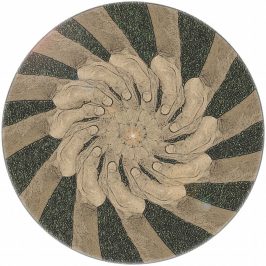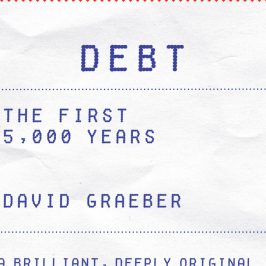Vinay Gupta is one of those hard-to-pin-down, hyper-productive people that seems to be everywhere once you start looking. The Hexayurt, a low-cost shelter made from plywood, is perhaps one of his best known projects – having found use in places from the Burning Man festival to disaster areas. I’d been trying to organise a meeting with him for a while when chance had it that we both went to the Emergence Summit at the Centre for Alternative Technology in Wales. We had a chat in between sessions about narrative, the Hexayurt, innovation and the Dark Mountain Project. The below is pretty much a direct transcription of that conversation. Thanks to Vinay for agreeing to share it here.
JDG: If the Dark Mountain Project is dealing with the metanarrative of progress: “let’s tell different stories, let’s start thinking non-linearly” how does that apply to innovation and physical objects? How do you see that in your work with the Hexayurt?
VG: This is a very good question. There’s an interesting story about a short story. So in 2005-6 I wrote a short story called ‘The Unplugged’ which is about four pages long and it is a very simple, almost character-free story, which is an interview with somebody who’s living on a 21st century housing estate that’s gone back to being this kind of feral community. And what they’ve got is a thing called the ‘unplugging movement’ which is a sort of open source collective of people who are going back to the land and sharing the knowledge of how to do it on the internet. And what makes them special relative to the hippies, or the poor, or the ordinary redneck, rural American, is that they’re very, very scientifically and technically minded.
So the ‘unpluggers’ are basically maintaining a shared knowledge base that helps them live their lifestyle, becoming what they call ‘farmer-scientists’, so they are researchers who also grow the food that they need to live. They’ve got some ties with industry for manufacturing so they are still partly grid-dependent but they’re increasingly doing their own stuff. It is just a very short picture of the future.
And I put that thing out there and it really got people to understand that the Hexayurt project was a key component to a systemic change. That once you can do the cheap housing the rest of the problem is much more soluble than housing is because housing is inherently very, very difficult. This is how I proposed we go forward: lots of developers, parallel development, open source pool, dependent on industry for the materials because we don’t know how to do that ourselves yet, but within the context that the long-term goal is substantial independence form the grid. But if I’d actually written that up as a policy document it would have been 68 pages!
In a story people can make the critical inferences from two sentences of dialogue with enough to give people the insight they needed to get what my actual deep motivation was. And that story is still kind of in circulation and every couple of years someone will reprint it or do something else with it and it will creep forward another round. That whole process was entirely and explicitly about using fiction to tell the… to get this stuff moving.
It’s a very powerful thing because it’s this fluid interface between fiction and reality that is actually the driving part of what makes me tick. I come from a Bruce Sterling novel called ‘Green Days in Brunei’ in which there is a Chinese-Canadian engineer that is trying to fix a robot factory to make plywood catamarans. And all the documentation has been eaten by termites! So he figures out how to get the robot factory to make a plywood boat, and then discovers that the boats are going to be used by the imprisoned head of a Buddhist technology movement to escape from Brunei and sail around the world building floating catamarans which are food farms. So the boat will sail across the ocean making food, making food, making food and then when it docks it hands out the food and the plans for the food and how you make the food yourself, and then sails on to the next one to give it time to accumulate more food.
And I looked at that and was like “I don’t like Buddhism, we could have a Hindu technology movement, plywood really is an amazing material and no one is really doing anything, I could do this!” Twenty years later here’s the bloody Hexayurt project. Right? And that thought when I was about seventeen that “I could do this!”, it was an identity that didn’t exist for me as a rural Scottish teenager who was into heavy metal. The notion that you could have a spiritual technology movement where the spiritual practice was building things! To make machines as a spiritual act.
This is unthinkable until you read the fiction and then it becomes possible. But the fiction only gets you to the possibility. Then you need the engineering. And this crux of fiction plus engineering is where modernity came from. Cyberpunk fiction, all the early science fiction, all the space fiction from the Soviet, you know, 1850ies to 1950ies kind of period… First it is as a dream, then it is as engineering, then it is as a political reality.
And it’s this interface between the artists and the engineers, between the storytellers and the engineers, that is power. All of the political stuff, all you can really do is stand in the way of that process and try and slow it down but every time you get a breakthrough where an engineer looks at a story and says “I can do this!”, breakthrough, breakthrough, breakthrough. And that is the war against the normals, right? Because normal people are embedded in a story that was told two thousand years ago, and it’s about sin and redemption.
That story is that the Christians win, and their kind of people inherit everything, and my kind of people are winked out of existence. And then we look at colonialism and colonialism is just an attempt to implement Christianity. Capitalism builds directly on top of colonialism. The whole rape of nature thing we are doing here: “man was given Dominion over it, it’s ours to do with what we like”. Meta-structure. Innovations which take us away from the Christian meta-structure are rained Hell upon… Once you understand that the metanarrative of Christianity empowers Western cultures’ colonialism, empowers the destruction of nature because we feel we need an apocalypse for the great state come back, right? This is why it’s so hard to get anything started! And to actually stand up and openly attack Christianity as the worship of demons that torture for fun. Right?
Yea, “so tell me exactly again where is Gandhi?”
“Oh, Gandhi’s in Hell.”
“Are you sure Gandhi’s in Hell?”
“Yea, no doubt about it. A Hindu, right? A Hindu. Died with the name of another God on his lips. Obviously going to Hell.”
“Really? What do you think Gandhi is doing in Hell?
“Oh, being tortured by demons.”
“No, I don’t think that’s what’s happening. I think he is organising non-violent, non-cooperation against his oppressors just like he did with the English. I think he is organising the people who are stuck in Hell to mount passive resistance against the regime that is headed by your so-called God. Isn’t it now obvious which side you are on?”
And watching the story snap! The force of that story is so large we invented the nuclear weapon and then allowed it to become normalised. Because it fitted with the apocalypse narrative. What we saw was the horrifically bad combination of desert Christianity, thousands of years old, with bang up-to-the-date physics. And you put those two things together and what you get is the power of the engineers used to manifest the horrors of the desert Christians. Right? A two thousand year old demon-worshipping sect lines up with twenty-first century technology, it is something out of a Star Trek story!
That nexus is at the heart of Dark Mountain. If you dig down deep enough what you get is this point where they step outside of the Christian frame and say “actually, we could have a future which is worse than the past, we could have a situation where things just keep getting worse and there is no sudden breakthrough, we could see a second Dark Age”. What’s the implication? “Uuuh, we hadn’t thought about it like that” but that’s actually the deep mythology inside of Dark Mountain. What happens when you step outside of that frame? So you can see the sort of structure of that framework, right? There’s a very, very deep story in there that we are all stuck inside of and then it’s a question of how do you break out of that?
JDG: So when we begin to step out of the metanarrative and we’re recognising that’s going on and we say “fuck that”, we then we start doing things differently… How do the new innovations we build outside the progressive metanarrative then travel on the cracks and the edges of normality? I guess that with the Hexayurt project, that you have experienced some of these dynamics of how it happens?
VG: That’s very interesting. Let me back up two steps and then I’ll come at it from a slightly different angle. So once you break out of the metanarrative, however you frame it, whatever your culture is, there are two or three different general directions. You can go into this kind of Goth nihilism where things only really have aesthetic value and try and make yourself comfortable. You can go back to a traditional metanarrative, you know, think of the breakdown of ordinary gender roles in the 70ies coupled with the resurgence of paganism. So, you know, your newly inspired feminists discovered there were no role for empowered women in Christianity but they had all of these latent goddesses who had fallen out of general use but but we still knew a lot about the worship of, and they begin to reboot that stuff. Because it gives them some notion of a role.
Now, you can also go into the future. So you have this kind of post-humanist, wonder hippie thing where we’re all going to wander around in white robes on little levitating disks. And we just have to hold it together until we can build this kind of new age utopia. And that vision was astonishingly pragmatic looking in the 1970s. In 1970 we’d just put a man on the moon. Technology can do anything. Why are we building these stainless steel cities when we could be building sort of rural utopias using the power of technology to give us the time and energy we need to practice our spiritual powers? And the hippies basically add a sort of NASA vibe in some places where they thought of themselves as being researchers into the fundamentals of human potential, the human potential movement, places like Esalen. They thought they were going to come up with some hard scientific results, it’s was going to be mainstreamed and by 1985 they’d be teaching levitation in primary school.
And given the shift that they’d made from 1960 to 1970, man on the moon, first computer, nuclear bombs, Cuban missile crisis, birth control pill, total break down of pre-existing sexual culture… You can’t imagine what it would be like to be in a culture where you couldn’t have sex without the risk of pregnancy attendant. Nothing made sense in that world. Right? People wanting to have sex, babies were likely the result, everything then becomes structured backwards from that fact. And we’ve pulled this linchpin out of civilisation as it stood and the whole thing was gradually collapsing. We’ve got no idea what gender roles are, we’ve no idea what the role of the state is, we’ve no idea what a family is because people are having sex without making babies! How are we to structure society? Nobody knows.
So the stretching of the narrative by technology creates fissures. You get to the point where technology stretches the societal story to breaking point and then the story snaps. And then what comes after that is various kinds of responses. Reversion to the past, different kinds of dreams, nihilism, aestheticism, whatever it happens to be. Those tear points, right? So what I discovered was you can’t change anybody’s mind about anything. You have to look for a place where people’s world models have already collapsed or where they are already embracing a new world model and then you just build tools. “Oh, you’re going from here to here? You are going to need a bag! You’re going to go from here to here? You are going to need a rural place to live and some cheap housing! Funny enough, I have this shed you might want to look at.”
For me the only way of getting the Hexayurt moving was by grafting it as a prop into other people’s stories. So part of the enormous confusion at the heart of the Hexayurt project is the Hexayurt project doesn’t seem to have a story. There’s ‘live unplugged‘ which is a very nice story and there’s ‘take my shed, please!’. But my own personal feeling about “we’ll do the refugee camps and do this and do that and do the next thing”, I very deliberately don’t tell that story because what I’m attempted to do is to make sure that the bloody Hexayurt gets everywhere, and the surest way to spread it is to not impose narrative drag. You could take the Hexayurt and you don’t have to drag the Hexayurt project story with you. Just take the prop because the prop is the story. The medium is the message.
So it’s de-narrativised in quite a radical way. This is also why there’s no story of ‘Mr. Hexayurt and His Amazing Hexayurt Are Going to Go Out There and Hexayurt the World’. You know, “look at the amazing Hexayurt guy, throw money at him, throw resources at him and tell the story of the Great Hero of the Hexayurt”. I very deliberately decided that I was not going to try and descend into the Bono-sphere with all the other celebrity do-gooders, that I was going to stick on the open source track to become like Stallman or Torvalds if I succeeded. On the basis that they remained working engineers in identifiably sane roles. What does Richard Stallman do for a living? He manages an open source project or two and talks to people a lot. What does Torvalds do for a living? He writes software and yells at people.
The stories about innovation basically fall into two camps. There’s ‘what we can do’ and there’s ‘what we ought to do’. The ‘what we can do’ guys are the 3D printer guys, they’re the Fab Lab guys, they’re the hackspace guys, whose story is defined by technical capability. They don’t really have a big picture of the world but it kind of comes out of a simple desire where they want the machines to do what they were told. It’s just knuckle-dragging natural politics with machines. Right? It’s a very simple narrative, there’s no social impact of it but the machines are being beaten into submission and that turns out to be socially important. Then you look at the hippies, or you look at the transhumanists, and what they have is a world transforming story where they are looking for capability to achieve the transformation they want top-down. The hackers, bottom-up.
Stallman bridges this. Stallman’s a hippie, he says “look, if we have free software, we have a free society”. Or at least the negative case “if we’ve got non-free software, we’re definitely not going to have a free society”. And what comes out of that is a process. It’s a very dangerous, delicate edge, but Stallman crosses that chasm because Stallman figures out how to get back inside of the technical role. Having set the initial trajectory, after that he just gets on with the knitting and it’s bottom-up led. That’s where the open source movement doesn’t have all the pathologies of the Bono-sphere.
The props are the key. It’s the relationship between the physical props and the story that is really the locus of action. So what I figured out was: you make new quasi-physical props, the stories change because now they have new props available they didn’t have before. I don’t need to control the story because there are only so many kinds of stories you can tell with this prop. It guides a particular kind of narrative. Right? All you can do with a flashlight is light the darkness and whack somebody on the head. All you can do with Goretex is turn a wet, cold human into a warm, dry human. And Goretex as a narrative object is basically safe, it’s very hard to weaponise Goretex. It’s very hard to use Goretex against somebody. Yea, you end up with soldiers in Goretex jackets but it’s a wet, cold human turned into a warm, dry human.
The first time that someone asked me to use the Hexayurt for anything military related, it was Haliburton in Guantanamo Bay. There was some scenario in which they were going to deal with some kind of humanitarian crisis in Cuba, they thought they might have refugees. Neither the thing they were afraid of happened or the Hexayurt but it was going to be Hexayurts in Guantanamo Bay built by Haliburton. And I got a phone call saying “Vinay, is this ok?” And I said “You’re kidding right? No you’re not kidding. Eh, yes, fine. tell them to give me a call if they have any questions”. And then it didn’t happen, thank God. But what a start that would have been, to have the first deployment of Hexayurts right in the heart of darkness.
Then that’s as bad as it could get. To have the evil people build Hexayurts for evil purposes. The hippies are much more empowered by the Hexayurt than Haliburton because Haliburton has other options. If you don’t have any choice but to build a Hexayurt and it’s a choice between building a Hexayurt and a tent… game changer. A teepee costs four times what a Hexayurt costs. A yurt costs ten times what a Hexayurt costs.
I deliberately didn’t spin narrative because what I wanted was access to other people’s narratives. I’m not going to give you a big narrative. You are going to take the thing I have and you are going to build narrative out of it because it only fits in these kinds of stories. And that prop engineering is what the open source world is doing. We’re going to build you props for your story, you’ll be in control of your prop. Your prop, your story, your game. That framing totally subverts the war of stories.
With the Hexayurt the prop we don’t have is land. We don’t control the stage. You build a Hexayurt but then someone comes along and says “we’re very sorry but that’s not up to building code, you have to take it down again because we used to live in shacks and we’re not going back to shacks yet”. The Hexayurt is jammed up hard against this in America. We’ve got, allegedly, quite a number of homeless families that got evicted and moved into Hexayurts on somebody else’s land. I don’t know where they are, but I keep hearing stories. Communes on the West Coast where people come back from Burning Man and put their Hexayurt up and live in it for the rest of the year. I hear stories. People aren’t documenting these things because if you start documenting the people living in Hexayurts, they’ll come and push you off your land.
The inability to build your own shelter and to live on your own land and to some degree by your own law is at the heart of the problem. Because if people go back to the land in a big way it does cut their environmental footprint enormously, particularly if gas is expensive. And you see how the pieces sort of ratchet together. It’s that ratcheting together that is really the long-term game plan. When all the other stories collapse, what’s going to be left at the bottom of the barrel is the shed, the composting toilet, the solar light, the wifi mesh node and a few other bits and pieces and they will be the props that exist when the other props are unavailable and then we’ll build a new story on that prop base.
This is the sort of Hexayurt apocalypse. If everything stopped working and all we had was this pile of crap… but it turns out this pile of crap is actually a good thing when you put it all together. “It wasn’t much fun the first few years but after that we got the farming going and it was just kind of like a vacation that never ended.” What was that? That was the end of civilisation, and it was the beginning of a vacation that never ended! The narrative that no one is willing to discuss in the Transition movement is “what if we don’t get energy descent?” All the way through this event [the Emergence Summit]: energy descent, energy descent, we are going to run out of oil. Had you noticed that solar panels went from £2.30/W to £1.60/W in the past five years? If it does that again it is cheaper than coal, if it does it again another time after that it’s cheaper than firewood. Right?
JDG: So how do you go about framing your prop? What you’re talking about is basically taking out the narrative, or de-narrativising, as you say. How does that get done?
VG: So that’s an analytical process. You look at the object and you try and forget everything you know and you imagine all the different ways it can be used. Pretend you are a monkey, right? What is it now? Oh, it’s a hammer. What was it before you were a monkey? It was a phone. So breaking down – and this is the sort of imaginative leap that science fiction authors are very good at – breaking down all the different things you could do with a piece of technology and then kind of permuting them.
Is there a way to abuse the Hexayurt? I’m sure there is. Is it abusable in a way that more expensive shelter technology isn’t? Probably not because most of the abuse cases require coercive force forcing people to live in Hexayurts. Actually, you can force them to live in a Hexayurt, you can force them to live in barracks, and the guard labour is probably the critical cost, not the shed. So it doesn’t empower them very much. Then you take a bunch of hippies with a pickup truck and it’s like “well, with one pickup truck load of wood we can build two or three Hexayurts”. What do you have as an alternative? “Oh well, we could build a log cabin and it is going to take us four trips for one room. OK, let’s see where this goes. Fair enough, off we go.”
So differentially empowering the weak rather than the strong is a pretty good design principle. Generally speaking, if it’s pooling the energy off a simple system, if it’s working in, you know, piecemeal steps from things that are already known to work and you build on layers on top of it… all of these things are reasonable approaches. A piece at a time, a layer at a time, a piece at a time, a layer at a time, a piece at a time, a layer at a time. Versus radical breakthroughs where we are going to take some new piece of biotechnology and push it down into villages to produce insulin and antibiotics for people… Argh! I don’t even know how to begin to analyse that back bit, this could go really wrong!
Part of why I keep calling the Hexayurt a shed is to keep people clear that it’s a shed. It’s not a spaceship, it’s a shed. You can make it in wood. If you can build a shed, you can make a Hexayurt. Is it possible to abuse a shed to end Western civilisation? We’re about to find out.






When the game is rigged and the ref is corrupt
Perhaps what we should fear most in this age of Collapse is the strain on...